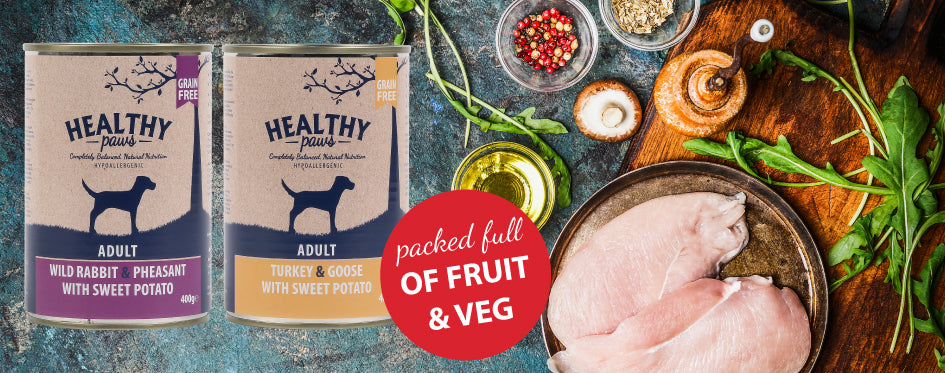Blog
Dispel The Myths About Dog Nutrition
Things you wish you’d always known about dog food
When you first have a puppy your main concerns are about making it feel at home, toilet training, teaching it to sit, stay, walk to heel and socialise with people and other dogs, no-one tells you what a minefield buying the right dog food can be, yet what a huge difference it can make to the new member of your family. Take a look at our ‘Bringing Your New Puppy Home’ post if you’d like to know more about feeding puppies in particular – this post is all about the ingredients used in dog food, because we are incredibly proud of the recipes we use for Healthy Paws and we’d like to help you steer clear of unhelpful ingredients.
Healthy Paws dog food uses 100% natural ingredients, it’s hypoallergenic and extremely palatable, which means that dogs love it and they thrive on the nutrition it provides. Here are some facts you may not know about dog food generally and reasons why there are some things you are best to steer clear of.
- The one key ingredient that can cause problems for a dog’s digestion is wheat. It can cause them to chew their paws, scratch their skin and generally feel under the weather. It’s wheat gluten that is the issue here and changing the diet to exclude wheat gluten can mean you have a happy, healthy dog within literally a few days. All Healthy Paws dog foods exclude wheat and wheat gluten – it’s a big No No for us.
- If a dog food says it contains cereal, that’s what’s known as an ‘open ingredient’, so it can change according to what’s available at the time of manufacture, so it could be barley, wheat, grass, roots and stalks or even soya bean mill waste. Some foods contain what’s called ‘wheat feed’ – that’s actually poultry waste which is also used as a fertiliser on fields – it is palatable for dogs, but it’s not great nutritionally.
- Not all gluten is the same. Wheat gluten tends to be the allergen for dogs, but gluten is a cereal protein and maize gluten, or prairie meal as it is sometimes called, is a prebiotic and hypoallergenic, so it can be a useful ingredient.
- The most important thing about dog food is the ratio between phosphorus and calcium. This is because phosphorus absorbs calcium and helps the body to replenish cells including bones and teeth. If there’s not enough calcium in the mix, then the teeth and bones will suffer. A balanced diet should see a ratio of 1.2:1 phosphorus to calcium or greater.
- Meat derivatives are also an open ingredient, so they can include all sorts of things that we wouldn’t normally regard as meat. Often people would think that meat derivatives are things like offal, hooves and ears. However, that’s not the case – there is more commercial value in selling hooves and pigs ears as treats than in putting them in as a component of the food. Meat derivatives in dog food are more likely to be things like veins and the scum found around the pan after cooking. Strangely enough we don’t like that idea for our dog food, so you won’t find meat derivatives in Healthy Paws food.
- Protein in itself does not make a dog hyperactive, fat is their energy source, meat protein is used for a dog’s muscle growth and is stored in different parts of their body, vegetable cereal proteins are mostly stored in fatty tissue. It’s generally artificial preservatives that make the dog hyper even though they are European approved preservatives.
- Some proteins are complex such as hair, feathers and hide – these cannot be broken down by dogs and these are listed as crude protein. However, good proteins can also be listed as crude, but you can tell the quality of the protein in the amount of food that is needed to feed your specific dog.
- Meat is also an open ingredient – that’s why at Healthy Paws we specify precisely what meat is used in our food. Because it’s an open ingredient, it can include roadkill and diseased animals. Farm animals cannot be fed meat products because of the possible transmission of disease. At Healthy Paws we think if it’s not good enough for farm animals, then it’s not good enough for dogs.
- Our recipes include diomethianine amino acid which gives the meat flavour, it also binds ammonia which will help stop lawn burn.
- Sometimes we’re asked what calories there are in our food – this is a flawed measurement for dog food – you need to look at the fat and the specific protein content because different sorts of proteins are used in dog food, some of which animals can’t break down. For example, some manufacturers will use feathers and leather as part of their protein content –a shoe might be 50% protein (leather), but that can’t be used as part of a calorie count as it has nothing nutritious in it. In other foods crude protein can mean protein from vegetables.
- Raw food is currently very fashionable, but be careful, if a dog has raw food and licks a child, the chance of it passing on bugs like salmonella is very high. A recent report from the United States has been very clear that feeding raw food can have a negative impact both on humans and dogs. We’ve all been taught to be very careful about preparing chicken for example, but we give raw food to our dog and think nothing of it then coming and licking us. Calcium/phosphorus levels are very important, so bone-on meat like chicken wings is better.
- Some pet owners prefer wet food – Healthy Paws wet food contains the good nutritious ingredients you find in the complete dry food. However, because wet food is generally made up of 80% water, you have to give some thought as to the actual proportions of protein and look carefully at how the protein content is labelled. For example, a 400 gram tin of wet food with 10% protein would have 40 grams of protein. The same 400 gms, taking 80% of it away for water content would give us 80 grams of dry food, 40 grams of which is protein, so it would actually be 50% protein content. Vets will often recommend a low protein food for kidney problems and people will buy wet food believing it is lower in protein when in fact it is higher.
- Ensure that you spend as much time looking at the ingredients of the treats that you feed as the food itself. If a dog has been given human food as a treat, for example sausages, they could well contain wheat and cereal – sausages for example generally contain 50% cereal. Healthy Paws fruit cookies have been developed using apples, pears and bananas, dogs love them and they provide a quick energy boost.
- Smell is more important than taste for a dog, so if a dog seems to be bored with its food (usually because it would prefer a treat instead!), the best solution is to put it in the oven for a few minutes to get warm. By releasing the odour from the fat content in the food, you’re suddenly making it much more appealing.
- At Healthy Paws we make use of garlic and herbs in our recipes to provide a natural preservative and to help prevent fleas and ticks. We also provide a herbal supplement if your dog has a particular requirement for this – Herbolistics contains a combination of 13 herbs and seeds which compliment your dog’s diet – this can be particularly useful if your dog has been unwell or seems to need a boost. It stimulates the metabolism and its seaweed content helps dental health.




